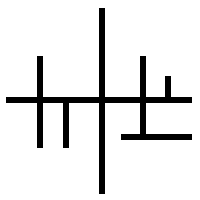The World’s Largest Wind Turbine Has Been Switched On::It’s turbo time.
According to the corporation, just one of these turbines should be able to produce enough electricity to power 36,000 households of three people each for one year.
These types of statements always trip me up. Why one year? If it’s producing that amount of energy in that same year, shouldn’t it just be “…power 36,000 households of three people.”?
As an engineer feels like the turbine will only work for a year
Watching global climate change, we may only need this for a year before we all pass.
Right. It will if this is another Tofu Dreg project
Because it does not run at the same capacity 24/7. Sometimes it produces energy for 0 households and sometimes for 50,000. Total production in one year corresponds to the yearly consumption of 36,000 households.
So they could just as accurately say “…power 36,000 households” And then fill in anything afterwards. “for 1 year”, “for 5 years”, “for the life of the turbine”. Or just leave it at 36,000 households. The “1 year” is so meaninglessly superfluous it annoys me. I mean, everyone knows they don’t produce power 24/365. That fact is always one of the disingenuous anti-renewable energy talking points.
In engineering, it pretty common to calculate things over a 1 year period in order to relate cost calculations to company finances. Most companies calculate their finances annually, so calculating for yearly average energy production makes any comparison easier than other arbitrary periods of time.
But it’s not superflouos? The number is apparently based on yearly average. Not on 5 year or over the total lifetime. And it does not produce only for 36,000 households but likely for many more. I don’t see why thin seems so meaningless to you or annoys you so much.
Why would the 5 year average be different than a 1 year average?
How should I know? Maybe it contains downtime for maintenance or sth? Point is these numbers are based on yearly average so why write about 5 years?
How should I know?
Exactly. Why add a time unit if it doesn’t communicate anything? It produces a year’s worth of energy per year, by definition. They could just quote the average power and be done but they tacked on “per year” for no reason.
Because most things like this are measured in average power per year and it is useful for comparison. Different technologies produce energy at different rates. Solar, only when the sun is up. How would you compare it to wind which has different rules?
Taken to an extreme, consider some hypothetical new technology that produced 50 Gigawatts of energy, but did it in a second and then took a year to recharge before doing it again. Would it be more useful to say it had a 50 Gigawatt capacity or that it provided 50 Gigawatts of power per year when trying to compare it to other technologies?
Edit: I hope nobody would use my hypothetical technology… Boom!
They’re leaving out an important part of the claim.
I can set up some piezoelectric things in my office chair such that when I sit my fat ass down it generates a small electrical charge. I can say that my ass can generate enough electricity to power a million homes for 10 years, assuming I don’t tell you how long it takes to generate that power, which would be on the order of decades, if not centuries, if not longer.
I’d wager someone saw the average energy output for the expected service lifetime of the turbine, then was like, “How much energy does one 3-person household use?” and started playing with Excel until they got a good mix of time and # of households for the press release.
Generally people compare the energy produced within the same period of time. There’s no need to add additional context since it’s pretty standard to expect that.
Does make me wonder if they mean an average. Like if the lifespan of the turbine is 50 years or whatever, so instead of saying 720 homes for 50 years they say 36,000 for one year to make it sound more impressive?
Going by their estimate of 36.000 households and the Dutch average yearly household usage of 3.500KWh that would be 126.000 MWh per year. One turbine is rated for a continuous output of 16MW which assuming it runs continuously, would give you 16x24x365= 140.160 MWh in a year.
I would assume they actually mean 36.000 households yearly assuming average weather conditions.
deleted by creator
Because using a yearly average is useful to account for fluctuations in power generation due to the change of the seasons. It might produce 50% of its power in 3 months if the fall usually is particularly windy in that part of the world.
Then how about “every year”, or “produces an annual average equivalent to”
deleted by creator
One eVinci micro reactor is enough for 5,000 homes a year and doesn’t depend on weather.
So, instead of manufacturing each of these giant blades that might last 20 years, we should instead be manufacturing three microreactors that are much smaller and easier to transport.
Mmh I love the smell of vaporware shilling in the morning
just one of these turbines should be able to produce enough electricity to power 36,000 households of three people each for one year.
per year? per lifetime? per second?
One year per year. And no, they obviously don’t understand basic math.
I took it to mean that in 1 year it will produce the equivalent amount that 36k 3-person homes would use during that same year.
In an average year it will generate what 36k homes use on average in a year.
50,000 square meters (nearly 540,000 square feet)
That’s approximately 4 square Walmarts
Finally, someone posts the American units.
You know, we Americans take a lot of shit for our measurements (anything but metric), but this really does put the numbers into a perspective that the article’s image just can’t convey.
or 1.2355 square furlongs
Article is inaccurate:
The behemoth is 152 meters (500 feet) tall, and each single blade is 123 meters (403 feet)
This is impossible, the total height cannot be lower than twice the length of the blades.
I found a better article: https://electrek.co/2023/07/19/16-mw-offshore-wind-turbine/
has a rotor of 260 meters (853 feet)
So it must be more than 260 meters high. Maybe 152 meters is the height of the tower? Generally the height of a turbine is measured as the high point of the wing tips. Which is what for instance air traffic must observe.
It is the tower that is 499 feet tall. https://www.sciencealert.com/the-largest-and-most-powerful-wind-turbine-ever-built-is-now-operational
Yes I figured as much, and added it to my comment.
It’s an impressive turbine, but whether it succeeds commercially remains to be seen.
It beats the Vestas 15 MW turbine, which has been tested for 3 years, and goes into production next year.
PS. The Vestas turbine is 280 meters high.
deleted by creator
Won’t somebody please think of the Albatross?!
Albatross? What flavor is it?
It’s turbo time
You’re not part of the turbo team!
Here is an alternative Piped link(s): https://piped.video/tIZujUfBrDM
Piped is a privacy-respecting open-source alternative frontend to YouTube.
I’m open-source, check me out at GitHub.
Has this ever happened to you!?
Caveat: I’m pro wind if it gets us off fossil fuels. It’s better than doing nothing and perfect cannot be the enemy of good enough (for now).
That said: in the late 1890s and early 1900s, scientists already knew about fossil fuels and greenhouse gasses and they didn’t speak up loud enough.
Take the idea of wind energy and project it’s growth a hundred years. From a pure physics perspective, when harvesting wind energy, you must steal kinetic energy from the wind. What happens when we’re harvesting say, 1% of all the kinetic energy of the atmosphere. Or 10%. Surely that will have major weather and climate effects. Or some far future anime sci fi outcome where we’ve captured 100% of the kinetic energy of the atmosphere and no air is moving except through turbines…
This turbine is very cool. What else should we be doing to prevent wind power from turning into the next generation’s climate disaster?
There is a whole lot of sky, my dude. I don’t think it’s plausible that we could capture even 1% of the kinetic energy of wind currents if we wanted to.
But also, wind is ultimately solar energy: the sun heats up parts of the planet at a time, the temperature differences cause pressure differences, and pressure flows from high to low. If we could somehow capture most of that kinetic energy, the result would be that areas which heat up stay warmer, and areas which don’t heat up as much stay cooler.
But we’re talking about gravity-bound gases, here. If we tried to capture too much, the gases would just find an easier route to equalize, such as going above our turbine network.
Not feasible now. Project a hundred or four hundred years. What if some future Elon is building fully AI controlled factories that do nothing but push out wind turbines that are getting increasingly taller to find moving air.
See also: the ocean is too big to pollute.
How high are you right meow?
When I was in grad school for planetary sciences, my fellow grad students decided I was naturally high. Is looking at the big picture being high? If so, meow.
Feasibility aside, it’d be a lot more practical to get cracking on that Dyson swarm. Photovoltaics are a much more efficient way to capture solar energy, or even direct solar thermal (ie mirrors and steam turbines)
Dyson swarm is great, but only if it isn’t beaming power back to the earth. If it’s beaming back energy to earth, we’re effectively pointing mirrors at the earth so it captures more energy from the sun. That’s sort of the opposite of what we’re trying to achieve.
But if we’ve got a Dyson swarm then we’ve got the power needed to do really intense weather modification, we could build a big facility in the south pole to refreeze it and beam the excess heat to Mars or one of the more distant space bases
Is it really stealing any more wind than say, a tall building though?
*than
Thank you
A tall building does not stop the wind. The wind moves around it. Think about it from a conservation of energy perspective: if the building stole the energy from the wind, that energy has to end up somewhere. The building isn’t converting that much of the energy into some other form (electricity, heat, etc.) so the energy must still be present in the wind. (Some small amount is converted to heat through friction when the wind hits the building, but it is tiny.)
It also transfers a non trivial amount of energy into the ground which I guess is kind of it’s job if you think about it.
In effect, it’s turning the energy it stole back into heat somewhere too, when the energy is used. Thermodynamics always wins.
A portion of it yes as the material flexes. But it’s not transforming it all to heat, most of it gets transferred through the structure and the building foundations into the ground. That’s my understanding at least, I’m not really sure how converting all the energy to heat would work but maybe I’m not understanding your point.
So, conservation of energy requires that if kinetic energy is removed from the wind, it must be converted to another form. If a building removes energy from the wind (through friction, flexing, transferring vibrations into the ground, etc.), that energy total must be equal to the kinetic energy lost by the wind. Thermodynamics says that any conversion of energy from one form to another results in some of that energy being converted to heat. So there’s some direct heating caused by the process of the wind hitting a building. That heat is largely heating of the air itself. After all, all those molecules had to collide with one another when they ran into the building.
The noise, vibrations, and other forms of energy conversion will all also end up as heat eventually, as they’re absorbed by the materials. So some indirect heating as well. In the ground, this is basically vibrations due a shuddering building being dampened by the material and turned into heat.
Now clearly on a windy day a building does not start significantly self-heating due to the wind hitting it. So the total amount of energy absorbed by a building cannot be that substantial. So, if one side of the equation (energy absorbed by building and converted into heat) is very small, then the energy removed from the wind must also be very small. Mostly the wind just changes direction to move around it.
Close, but not quite. One cubic meter of air at atmospheric conditions is about 40 moles, or 575 grams. Let’s say 600 g to be generous.
Wind moving at 250 km/h (cat. 5 hurricane) contains about 1.5 kJ of kinetic energy per cubic meter.
If all that energy is used to heat the same air, it’s temperature is increased by roughly… 3.5 K.
Now consider the fact that kinetic energy scales as the square of velocity: for a normal windy (say 15 m/s wind), we only get a temperature increase of 0.16 K, which is practically immeasurable.
For these calculations I didn’t even consider the building, which has a massive specific heat capacity compared to air.
In summary: Because the thermal energy required to increase temperatures appreciably is of a completely different order of magnitude than the amount of kinetic energy in the wind, the fact that a building isn’t heating up is not a solid argument that only a small portion of the kinetic energy in the wind is being lost when it hits the building. In fact, even if all the energy was lost, you wouldn’t even notice the temperature change, unless you were in a cat. 5 hurricane, in which case the building is probably already gone.
I see what you mean but I don’t think your base assumption is correct. Energy can be transferred as well as converted to other forms, which is what happens to the vast majority of the energy removed from the wind in the case of it hitting the building It gets transferred to the ground, not converted.
If the wind hitting something converted all the kinetic energy to other forms rather than transferring most of it, the sail wouldn’t work for driving a ship for instance. Again, maybe I’m not catching what you mean here so I’m sorry if that’s the case. It’s true everything will eventually become heat, as in the heat death of the universe, but looking at the example of the building resisting the wind in isolation only a tiny fraction of energy ends up as heat rather than being directly transferred. I’m no physicist but that’s my understanding.
What happens when we’re harvesting say, 1% of all the kinetic energy of the atmosphere. Or 10%. Surely that will have major weather and climate effects.
What else should we be doing to prevent wind power from turning into the next generation’s climate disaster?
Stop making assumptions, don’t jump to conclusions. Do the science, gather data, apply math.
Until then, we can at least appreciate global warming means an increase in atmospheric energy or wind speed and availability. We should rather be worried about storms damaging turbines.
You’re getting shit on for asking questions, but these articles seem to bring out the worst in armchair engineers.
It’s worth remembering that wind is the result of solar flux adding energy to our atmosphere. From a practical perspective, we can’t deplete the energy as it gets added constantly no matter what we do. Putting big turbines in the wind does alter local flow profiles but, again from a practical perspective, the mass fraction of air flow modified is minuscule. Further, part if the design of wind farms includes making sure that the turbines stay out of each other’s wake, sort of like keeping solar panels on a solar farm from being in the shadow of another panel.
To bring solar into it again, the concern about stopping the wind is like the concern for overheating the planet by putting up to many solar panels. You see, solar panels have a higher albedo (absorption) of solar radiation than the planet, on average. It’s like pavement vs a gravel road - the pavement is going to heat up more. If you run the numbers, though, the effect is negligible, more like adding 1 dark rock out of every 1000 to the gravel road.
We use, worldwide, something like 1/10,000th of the solar energy that falls on earth. It’s often worthwhile to ask questions like yours, even if only to offer a vehicle for explaining why and how engineers and scientists have had the same questions and found the answers.
Stay curious, friend.
Why are you trying to blame “scientists for not speaking up loud enough” and not the ruling class and politicians who have time and time again worked against the interest of people and the stability of Earth’s climate in the name of quarterly profits and claiming lower taxes.
And then you’re suggesting that the climate impact of wind turbines is going to cause more changes versus what we’re already doing.
Do you not think trees? Buildings? Cars? Other mega structures? Are not already changing the way wind is moving? Look at the physical profile of a wind turbine, how much space does it take up at once? Now compare that to the face of a building. How many tens, hundreds of blades could fit in that space? Compare that to Earths entire atmosphere. And you’re out here suggesting somehow we’d be at 10% coverage? Even 1% is completely outlandish.
You claim to be pro wind and then just offer absolutely absurd arguments against it. And you’re acting like we’re doing enough with our current climate crisis to run into another disaster in the future. Wishful thinking, honestly we’ll be lucky if we can get far enough to have the issues you’re imagining.
There is no one solution, that’s how we got ourselves into this mess.
Diversify energy production and reduce energy use, make more efficient houses, cars, machines, work places, more energy efficient living.
Wright’s Law applies to solar panels, wind turbines, and more. Basically, as production capacity increases, the cost of production decreases by approximately the ratio of 18% for each doubling of production capacity. This equation will continue to drive the total energy production capacity up while driving energy costs down. With abundant cheap energy, we will keep finding things to use it for.
On an individual level, this looks like: you installed LEDs, so now you have budget available to run the giant TV.
Basically, even though we become more efficient in our daily lives with regard to energy use as individuals, the more energy we produce and use as a civilization. Cheap energy enables progress. Yes, the CPU in your cell phone is very energy efficient, but the energy it took to manufacture it isn’t included in your calculations. The more advanced our stuff becomes, the more energy it takes to make it, and run civilization itself.
There is very little you can do as an individual to change the trajectory of global energy production and consumption, but we can at least try to choose better energy sources. The only thing we can do as a civilization in the very long term would be to move production off planet. Or, you know, revert to a stone age civilization where everyone ceases to exist.
I think there’s a lot of currently unknown factors involved, for a lot of things we’ll reach a point where the technology is evolved to a point much more efficient than current solutions. It’s possible as well that these systems will make effective use of small cycles so we’re only having to put very small amounts of extra energy into it to maintain the cycle.
Automated construction tools could for example make it very cheap to install grey water systems and water filtration which greatly reduce the demand on our current supply and sewer systems. Likewise with TV, we currently have big screens but a small headband that interacts with the optic nerve or brain might be far more efficient. If most houses can generate the power they need locally then huge parts of the electrical grid could be removed which would save huge amounts of power.
I think we’ll always want to do big projects and use more power for science and community growth but hopefully a lot of that can be done in space or areas that are especially well suited such as deserts or floating platforms in the ocean where room and power are cheap.
deleted by creator
Renewables is plural for a reason. We need to combine multiple sources just as we have done with fossil fuels. Solar, geothermal, ocean currents, etc all compliment wind nicely.
The real challenge is energy storage. Fossil fuels are effectively batteries until we expend them.
Also distribution. It’s relatively cheap to transport energy in the form of hydrocarbon type fuels because most of your fuel(oxygen in the atmosphere), is in abundant supply pretty much everywhere. Solar has huge variation in seasonal production at higher latitudes, geothermal, hydro, and wind power tend to be most economical in places where the geology/topology is favourable.
Valid point and not one that I had considered. Thanks.
That said: in the late 1890s and early 1900s, scientists already knew about fossil fuels and greenhouse gasses and they didn’t speak up loud enough.
Are you just going to ignore that battery technology sucked 100+ years ago and that’s why the ICE beat the electric engines? Everyone has to work with the technology of their era. 100+ years later and batteries are still a bottleneck for us today and one of the main areas of focus to make a lot of this stuff work, and there is still a question if we’ll have enough resources to produce the number of batteries we’ll need if we don’t come up with some new/better technology.
It’s easy to blame the past when you ignore the limitations of the time. We will undoubtedly make mistakes that have unintended consequences. Does that mean they are mistakes at the time, or did we just do the best we could with the information and technology we had available? That’s all anyone is trying to do. That’s all anyone has ever tried to do. No one in 1900 decided they’d use fossil fuels, just so they could piss off Troy in 2023.
Fair enough, but if humanity had geared up for renewable electricity generation, there would have been more motivation to fund and perform research on battery tech.
Why would they focus all their energy on solutions that only worked when the weather was nice, and thus electricity was needed the least? That doesn’t make sense. It’s a chicken and egg situation. They’re not going to make renewable energy they can’t store, and there not going to focus on mass storage when the solutions of the day didn’t require it.
Regardless of how we got here, we’re here. So we need to accept it and figure out the best way forward. Pointing fingers at the past is completely pointless. What happened, happened.
Wow. It’s great that you thought of that!! Thankfully, scientists almost as smart as you have already created a model that specifically keeps us from stealing all the wind. It’s somewhere around 60% and under and we’ll be fine.
In the 19th century internal combustion engines commonly ran on grain alcohol, but it was too expensive and too hard to mass produce so they went to petroleum based fuels. Electric cars have existed since the invention of the electric motor, but they’ve always been held back by battery technology. An electric car that uses hydrogen fuel cells in conjunction with batteries would be more environmentally neutral while improving usability, but the cost of fuel cells and logistics of hydrogen fuel makes it infeasible.
Advancement in our way of life has always been driven by profit. If it’s not profitable, forget it. Advancement may even be held back by companies that see it as a threat to profit. Environmental impact has historically been a background concern. It’s not until the damage has become an actual threat has it moved to a forefront consideration. And solutions are mostly driven by government, not the responsible profiteers.
Tech is now pushing toward sustainable solutions, but it’s still profit driven. Business is looking to capitalize on new markets that have been opened up by government subsidy and popular opinion. It should have been there from the start, but the desire was never there. The attitude of government and big business in the first half of the 20th century was destructive. They felt the Earth was a resource to be plundered without regard for anything but profit.
We have to turn around over a century of damaging industry and way of life. It’s got a lot of inertia and it’s going to be hard to do. I think the human race is going to have to reap what it has sown and it could get pretty bad. We’ll have to get through it and change our way of life so it doesn’t happen again. If we become caretakers instead of destroyers the Earth can survive this era of human impact and heal much like it has for natural calamities in the distant past.
In the simplest models the bulk of wind is mostly caused by two major factors. The sun heating parts of the earth’s atmosphere creating high pressure zones and the Earth’s rotation displacing air.
The only observable effects we’d see in the conceivable future are that scaling wind energy utilization would decrease the effectivity of other technologies that rely on wind vs such as sails or wind turbines, as wind turbines locally disrupt airflow patterns.
The larger environmental cost of them like many green energy solutions would be the materials used in their manufacturing and the energy spent to haul them to their site of deployment.























